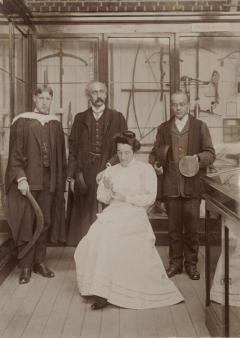See Francis Knowles introduction

Francis Knowles, Henry Balfour, J.A. Harley, and Barbara Freire-Marecco in the Pitt Rivers Museum 1998.266.3
His interest then seems to have moved to physical anthropology and the study of human remains, first in the Department of Human Anatomy (under Arthur Thomson, who must have taught him during the Diploma) and then in Canada.
At some point around or before 1904 he must have become interested in collecting stone tools because he donated his first series of artefacts from Biddenham in Bedfordshire in that year, to the Museum. He continued donating, exchanging and selling artefacts to the Museum for the remainder of his life. The fact that he occasionally exchanged items suggests that he also maintained a private collection of ethnographic artefacts (he may also have maintained a private collection of stone tools as items came from the same provenances in different years). In exchange for stone tools in 1906 [1906.63.1] he was given '2 fine assegais (collected in 1857) from Natal Pres[idency] by J. Rigaud 1887 [sic] I 33' [1888.28.7, NB actually given in 1888]. In 1908 he was given 'a kris from Macassar, Celebes, Chittenden Collection, purch[ased] 1907 (no. )' [1907.75.43]
Knowles obviously discussed collecting with Henry Balfour, the Curator at the Museum and his mentor during his Diploma, who advised him to collect all the stone tools he could find, not just the fine specimens. One of the first, and largest sources, of the donated stone tools and other archaeological artefacts and fossils was Biddenham in Bedfordshire, which Balfour seems to have encouraged Knowles to search in. [Knowles, 1953: 14-5] Knowles gave a total of 1,582 artefacts from this source from 1904. Most were donated by 1910. According to http://www.irsociety.co.uk/Archives/17/Beds_1.htm the gravel pit at Biddenham was '... owned by S.W. Jarvis & Son, a firm of stone and monumental masons in Alexandra Road, Bedford.' In total Knowles gave 2,688 artefacts to the Museum, most of them stone tools.
Knowles was not just interested in finding and donating stone tools. He was interested in how they were made and the specific skills and technological advances that would have been required to produce specific types of stone implements and weapons. He became a very fine flint knapper but he also drew many thousands of stone tools. He taught these skills to the successive generations of Diploma students at the Museum. He used these practical skills both to identify particularly fine specimens of the stone-worker's art, but also to create displays (now, alas, all removed) which demonstrated this knowledge. Some of the displays were only removed in the last few years. When the displays were demolished records were kept, one artefact, 1995.20.2 has this note:
Previously on display in U45.A (Archaeology - Stone Tools) until this display was dismantled for building work. The case was titled 'Stone Tools' and the section in which this object was displayed was subtitled 'Experimental flakes produced by various techniques'. This object was labelled as number '51' in the display and listed on the group label as '50-52. Blue glass, plain glass and light green glass flaked spear heads. Bottle glass such as that displayed here was used in Australia to made [sic] spear heads using exactly the same technique as that previously used for stone, except that the final edges were sometimes retouched using the teeth. Made by Sir F.H. Knowles in his experiments on flaking. 1995.20.1-3'
However, as another note records, this might also have been made by Fred Snare of Brandon, and be part of the series [1899.84.9-13].
It seems that his knowledge, passed down both personally and through his two Occasional Papers, is still of importance to flint knappers today.